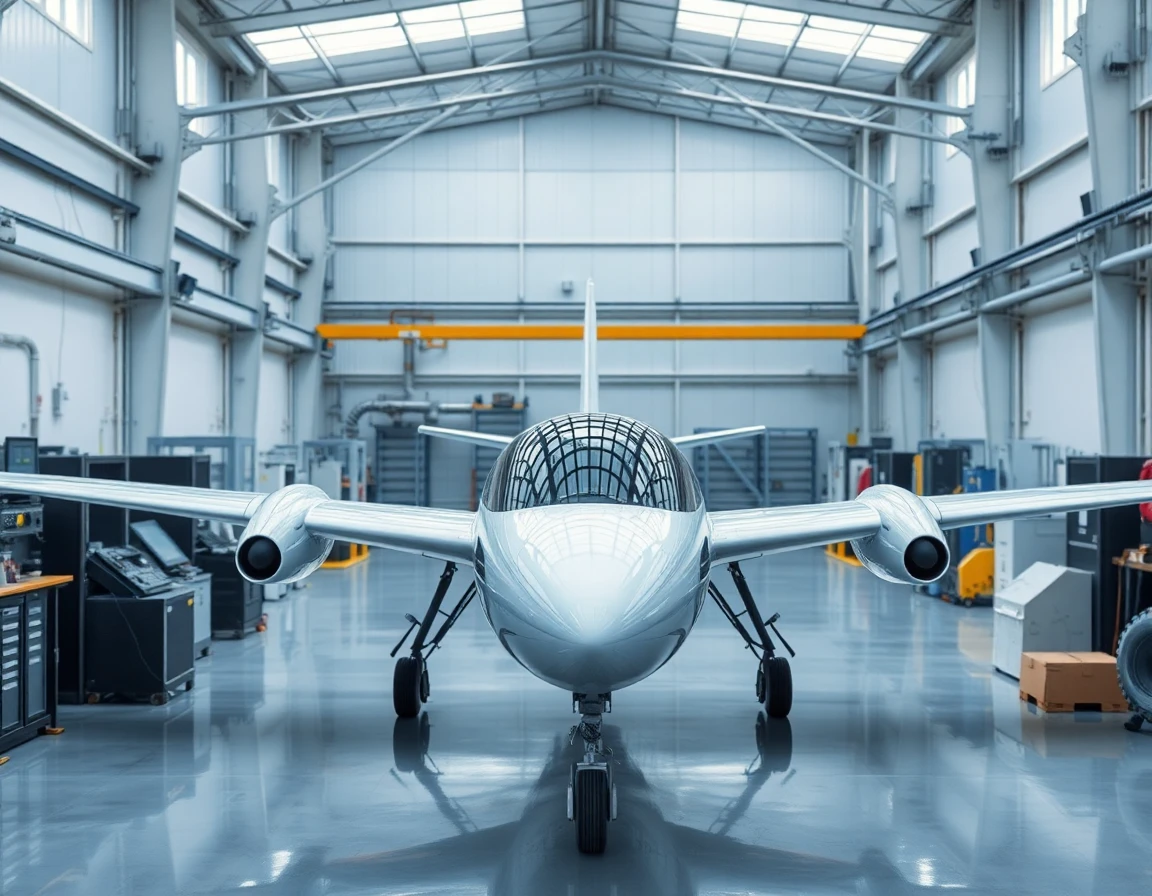The aerospace industry is undergoing a transformative phase as electric aircraft technology advances rapidly, promising to redefine air travel with cleaner, more efficient options. Recent developments across various sectors, including urban air mobility and military applications, highlight significant strides in electric propulsion, hybrid designs, and hydrogen-electric powertrains. Collaborations between industry leaders, academic institutions, and government entities are driving this evolution.
Electric Vertical Takeoff and Landing (eVTOL) Aircraft Development
One of the most exciting innovations in electric aviation is the development of Electric Vertical Takeoff and Landing (eVTOL) aircraft. A notable project is being led by Georgia Tech in partnership with NASA, focusing on a quiet, battery-powered eVTOL aircraft designed for urban environments. This aircraft, which will weigh approximately 1,000 pounds, aims to reduce traffic congestion in metropolitan areas by flying over them with minimal noise and zero emissions. By replacing short-haul business jets, this initiative could significantly decrease urban air pollution and enhance transportation efficiency.
Meanwhile, Electra.Aero is making strides with its EL9 Ultra Short hybrid-electric aircraft, which boasts a remarkable capability to take off and land in as little as 150 feet. By leveraging hybrid-electric propulsion combined with blown-lift aerodynamics, the EL9 is engineered for operation from small airports and unconventional sites, including parking lots. With over 2,200 provisional orders worth $13 billion, Electra is poised to begin flight testing in 2027, with aspirations for FAA certification by 2029-2030.
Advancements in Hydrogen-Electric Propulsion
Amid the push for sustainable aviation, hydrogen-electric propulsion is gaining traction. French startup Beyond Aero has bench-tested a full-scale hydrogen-electric powertrain for its BYA-1 business aircraft. Designed to accommodate six passengers, the BYA-1 targets an impressive range of 800 nautical miles with zero emissions, showcasing the potential of hydrogen as a viable alternative to traditional battery technology. This development is a significant step forward in the quest for clean propulsion technologies that can reduce aviation’s carbon footprint.
Commercial Adoption and Technical Demonstrations
The commercial adoption of electric aircraft is gathering momentum, as evidenced by Air New Zealand’s recent test flight of the Alia CX300, an electric conventional takeoff and landing (CTOL) aircraft developed by Beta Technologies. This four-month technical demonstration program aims to familiarize pilots and engineers with electric aviation technology while evaluating the aircraft’s performance in real-world conditions. The Alia CX300 represents a crucial step in integrating electric aircraft into commercial operations, paving the way for future electric fleets.
Military Interest in Hybrid and Electric Aircraft
The defense sector is also keenly interested in hybrid and electric aircraft capabilities. Hybrid Air Vehicles Ltd has announced the reservation of three Airlander 10 hybrid aircraft for military purposes. The Airlander 10 stands out for its fuel efficiency and long endurance, capable of operating for up to five days without refueling. Its versatility makes it suitable for various roles, including intelligence, surveillance, reconnaissance (ISR), personnel transport, and even drone swarm operations. Its ability to operate from flat surfaces, including water, adds to its unique military applications.
Academic Research Addressing Challenges
As the electric aviation landscape evolves, academic institutions are playing a vital role in overcoming technical challenges. Embry-Riddle Aeronautical University has partnered with Brazil’s Instituto Tecnológico de Aeronáutica to study thermal management of electric aircraft batteries. This three-year research initiative aims to develop innovative cooling strategies necessary for ensuring the safety and efficiency of electric flight, addressing one of the most significant hurdles in electric aircraft technology.
Challenges and Setbacks in Electric Aircraft Development
Despite the promising advancements, the journey toward widespread electric aviation is not without its challenges. Recently, AIR Electric Aircraft’s prototype crashed during a test flight in Florida, prompting an investigation into the cause. This incident serves as a reminder of the inherent risks and challenges that accompany the development of electric aircraft, underscoring the need for rigorous testing and safety protocols.
Future Outlook: A New Era of Aviation
The landscape of aviation is on the brink of a revolutionary change, driven by electric aircraft technologies. As stakeholders across the aerospace and defense sectors collaborate to push the boundaries of innovation, the potential for electric and hybrid aircraft to transform urban air mobility and military operations is immense. By harnessing advancements in precision accelerometers and other cutting-edge technologies, the industry is well-equipped to tackle the challenges of electric flight.
The ongoing research and development efforts, coupled with significant commercial interest, suggest that the future of electric aviation is not just a possibility but an impending reality. As these aircraft take to the skies, they promise to usher in a new era of sustainable, efficient, and versatile air travel.
References
-
Engineers achieve incredible potential with … (www.thecooldown.com) - 10/24/2025 Georgia Tech researchers are working with NASA to find a clean and quiet answer to gridlock. It could be electric aircraft.
-
AIR electric aircraft prototype crashes during Florida test flight (aerospaceamerica.aiaa.org) - 10/24/2025 Aircraft crashed in a field for unknown reasons and was consumed by post-crash fire. — NTSB Newsroom (@NTSB_Newsroom) October 23, 2025. The company flew the …
-
Hanwha Aerospace orders more GE engines for military … (avitrader.com) - 10/24/2025 Hanwha Aerospace (Hanwha) has signed a new agreement with GE Aerospace to purchase more T700 and F404 engine kits.
-
1st Military Aircraft Reservation for Airlander (www.asdnews.com) - 10/23/2025 The three aircraft have been reserved by an innovative defence contractor looking to deliver the unique capabilities of Airlander to its …
-
Air New Zealand launches its first electric aircraft (thedriven.io) - 10/21/2025 Air New Zealand launches its first electric aircraft. 21 October 2025 · 2 comments; 3 minute read … Your best source for electric vehicle news & analysis.
-
Students Tasked with Studying One of Electric Aviation’s … (aiaa.org) - 10/20/2025 Students Tasked with Studying One of Electric Aviation’s Biggest Challenges Written 20 October 2025. Home/News. In This Section. Press Releases · AIAA News …
-
Electra.Aero Selects Evolito to Power EL9 Hybrid-Electric … (www.ainonline.com) - 10/13/2025 October 13, 2025. Electra.Aero has selected Evolito to provide electric propulsion units (EPUs) of its EL9 Ultra Short hybrid-electric aircraft.
-
The Week in Technology, Oct. 6-10, 2025 (aviationweek.com) - 10/6/2025 Beyond Aero is developing the hydrogen-electric BYA-1, designed to fly six passengers up to 800 nm with zero emissions. Credit: Beyond Aero.
-
Electra Expands U.S. and European Facilities to Accelerate … (www.electra.aero) - 9/30/2025 Recent News. October 13, 2025. Electra Selects Evolito to Supply Electric Engines for the EL9 Ultra Short Hybrid-Electric Aircraft. October 13, …
-
Pulitzer Electric Aircraft Race prepares for takeoff (generalaviationnews.com) The Pulitzer Electric Aircraft Race will bring together pioneering pilots and cutting-edge aircraft Oct. 10-15, 2025, …



